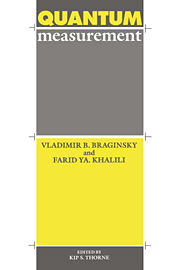Book contents
- Frontmatter
- Contents
- Dedication
- Editor's Foreword
- Notation
- Chapter I Historical introduction: photons and measurements using photons
- Chapter II The main principles of quantum mechanics
- Chapter III Indirect measurements
- Chapter IV Quantum nondemolition measurements
- Chapter V Linear measurements
- Chapter VI Continuous linear measurements
- Chapter VII Nonlinear systems for continuous measurements
- Chapter VIII Detection of classical forces
- Chapter IX Energetic quantum limitations
- Chapter X Devices for measuring small mechanical displacements
- Chapter XI Quantum nondemolition measurements of a resonator's energy
- Chapter XII Nonclassical states of electromagnetic waves as tools for quantum measurements
- Conclusion
- References
- Subject Index
Editor's Foreword
Published online by Cambridge University Press: 15 December 2009
- Frontmatter
- Contents
- Dedication
- Editor's Foreword
- Notation
- Chapter I Historical introduction: photons and measurements using photons
- Chapter II The main principles of quantum mechanics
- Chapter III Indirect measurements
- Chapter IV Quantum nondemolition measurements
- Chapter V Linear measurements
- Chapter VI Continuous linear measurements
- Chapter VII Nonlinear systems for continuous measurements
- Chapter VIII Detection of classical forces
- Chapter IX Energetic quantum limitations
- Chapter X Devices for measuring small mechanical displacements
- Chapter XI Quantum nondemolition measurements of a resonator's energy
- Chapter XII Nonclassical states of electromagnetic waves as tools for quantum measurements
- Conclusion
- References
- Subject Index
Summary
The quantum theory of measurement has been widely regarded, since the 1940s, as an esoteric subject of little relevance to “real” physics. Quite the opposite was true in the 1920s and 1930s when Niels Bohr, John von Neumann, and others were struggling, by means of gedankin experiments, to develop an understanding of how measurements on single quantum objects were to be incorporated into quantum theory. However, the understanding they achieved turned out to be of little use in the quantum mechanical applications that commanded the attention of physicists between 1940 and 1980: the interaction of photons, atomic nuclei, and elementary particles, the theory of masers and lasers, the properties of matter (superfluidity, superconductivity, semiconductors), etc.
In each of these applications, although the phenomena studied were quantum mechanical at heart, the measurements used to probe them were so far removed from the quantum domain that the only feature of the quantum theory of measurement which entered into the experiments was the probability interpretation of squared amplitudes. There was no need to invoke what soon came to be regarded as an esoteric, problematic, dubious “collapse (reduction) of the wave function.”
Fundamentally, the reason for this irrelevance of the quantum theory of measurement was technological.
- Type
- Chapter
- Information
- Quantum Measurement , pp. xiii - xviPublisher: Cambridge University PressPrint publication year: 1992

